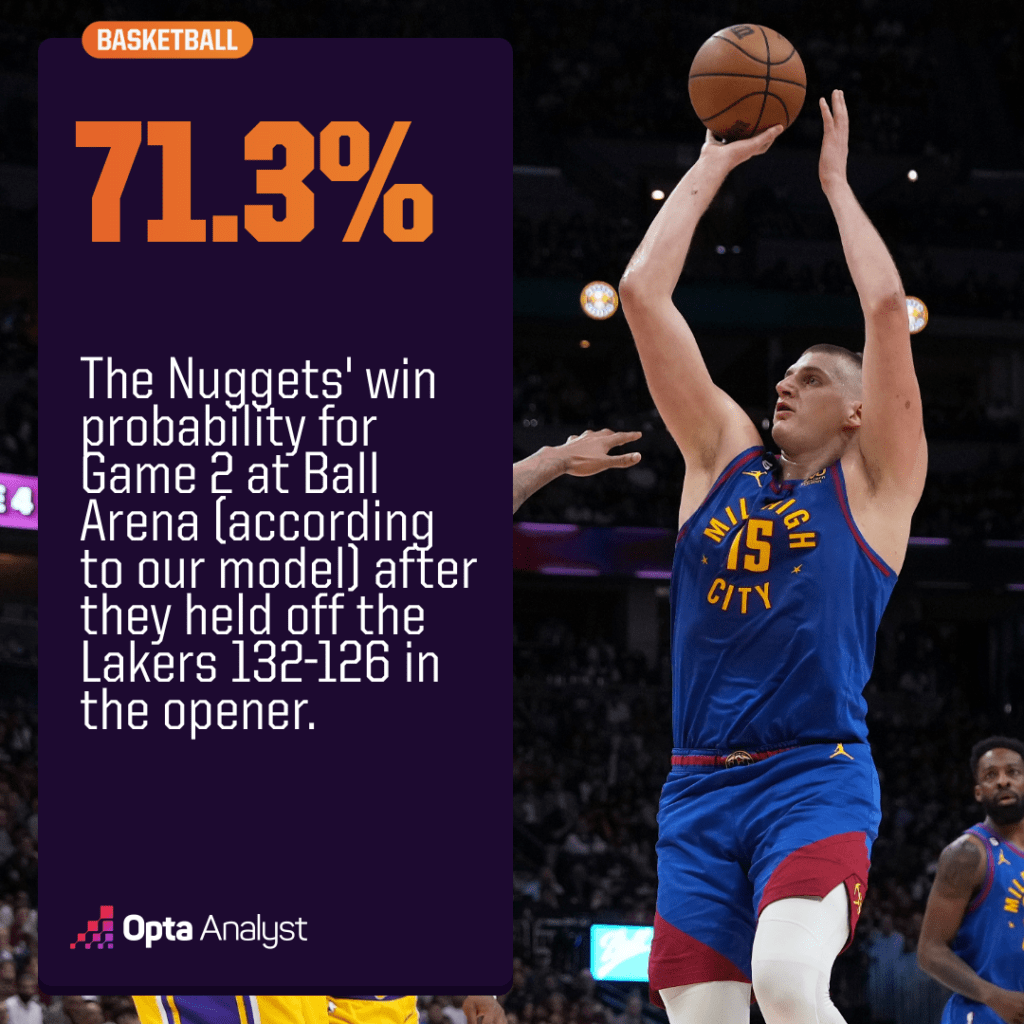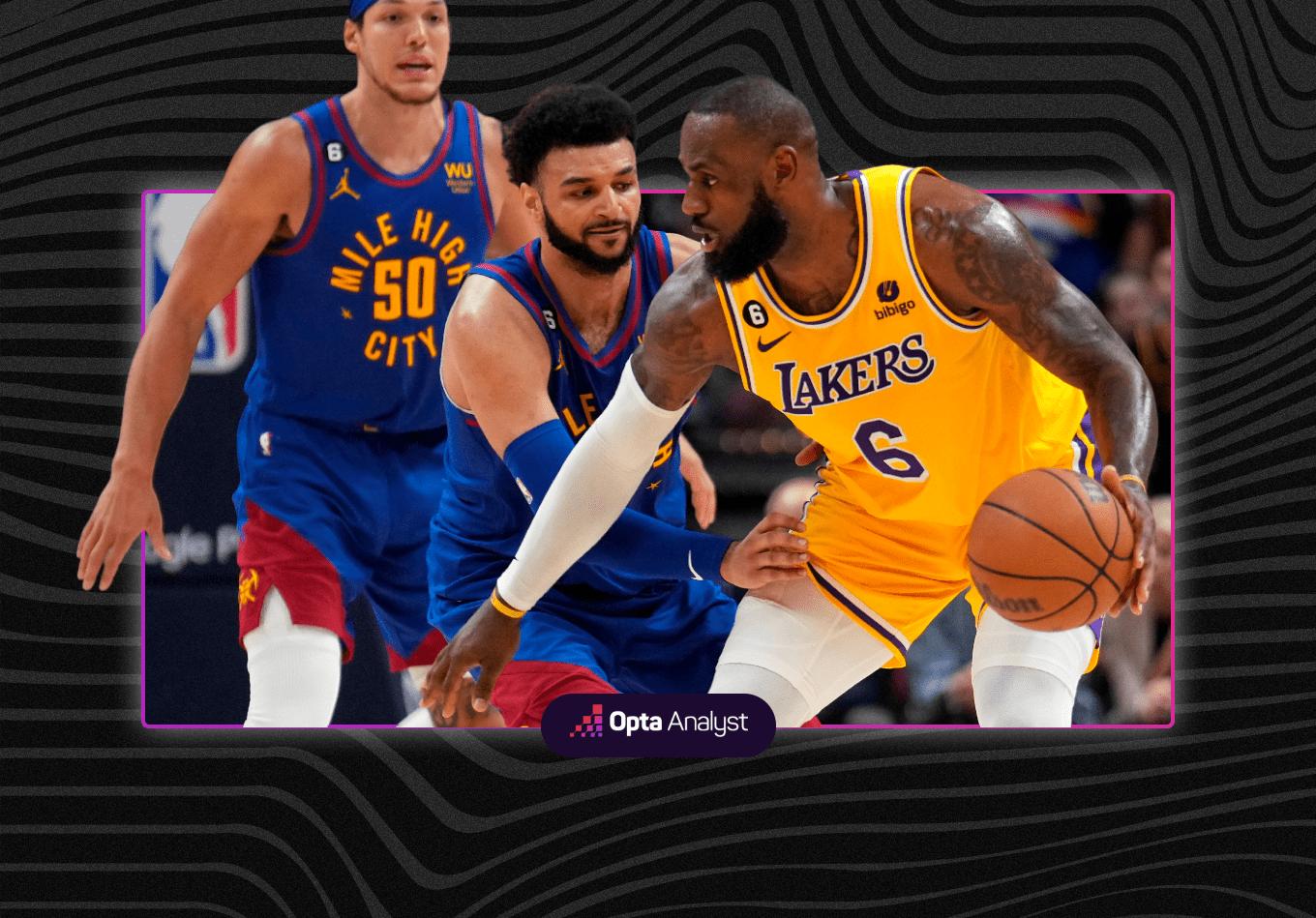LeBron James has stepped it up offensively. What kind of impact will his aggressiveness have on Game 2? We break it down while also revealing our player projections and Lakers vs Nuggets prediction.
Through 11 NBA playoff games this year, LeBron James played like a passenger rather than a driver, inviting teammates such as Anthony Davis, D’Angelo Russell and Austin Reaves to headline or punctuate possessions, while he aimed to space the floor, attack gaps and seek fast-break opportunities.
Yet despite the Los Angeles Lakers standing only a win away from their return to the Western Conference finals at that juncture, James wasn’t notably effective in such a role, with the mastery he’s made so commonplace largely confined to short spurts. He settled for a ton of jumpers, didn’t look particularly explosive when he tried to shift gears and rarely shouldered a consistent playmaking load, averaging 23.8 points (55.8% true shooting) and 5.0 assists.
To eliminate Stephen Curry and the Golden State Warriors, James busted out of his funk and retooled his approach, notching 30 points and nine dimes in a 122-101 rout of the defending champs. On Tuesday, in Game 1 of the Western Conference finals between the Lakers and Denver Nuggets, James maintained that approach with 26 points and nine assists as Denver outlasted Los Angeles for a 132-126 victory.
While the Nuggets emerged victorious, the stingy defense they showcased the first couple rounds sprung various leaks, led by James’ intrepid nature. Over the past two games, he’s averaging 28.0 points (70.6% true shooting), 10.5 rebounds and nine assists. He’s no longer resigning himself to tenuous jumpers or operating primarily off the ball. He’s taking matters into his own hands and bouldering his way to the hoop.
In his first 11 playoff games, he had a 3-point frequency of 38.1% and a rim frequency of 32.2%. His free-throw rate was only .257, while 56.3% of his field goals came via assists. Dating back to Friday’s Game 6, his 3-point frequency is down to 23.3% and his rim frequency has spiked to 43.3%. During that span, his free-throw is up to .733 and only 36.8% of his field goals are assisted.
Opta Analyst’s Player Projections for Game 2 – Lakers
- Anthony Davis: 24.96 points, 15.13 rebounds, 2.85 blocks
- LeBron James: 24.62 points, 9.39 rebounds, 6.00 assists, 2.19 3s
- Austin Reaves: 15.40 points, 4.54 rebounds, 4.25 assists, 2.14 3s
- Rui Hachimura: 12.04 points, 5.15 rebounds, 1.22 3s
- D’Angelo Russell: 11.98 points, 4.25 assists, 2.11 3s
- Dennis Schroder: 10.86 points, 4.08 assists, 1.20 3s
Haggle over small sample size, but there’s absolutely a discernible change in how James is being deployed and how he’s utilizing his touches that are lending themselves to a much more impactful player lately. Between late February and late March, he missed 13 games because of a tendon injury in his right foot that at one point seemed like it may require surgery. Nearly three months removed from the setback, he could be regaining his superstar form. He’s certainly played like it recently.
Time and time again on Tuesday, James leveraged his strength into drives or paint touches. Ideally, Denver’s counter for this is Aaron Gordon, who has assumed the primary assignment against James thus far. The issue, though, is the Nuggets were content to concede an advantageous switch for James virtually whenever he wanted.
Usually, that switch meant involving Jamal Murray, who James targeted as often as possible. Murray logged 31 points and five assists, but was incredibly detrimental defensively because of James’ game plan and Denver’s willingness to amplify it. James wasn’t the lone Laker implementing this bully-ball strategy. Rui Hachimura followed suit against Denver’s guards and had 17 points on 8-of-11 shooting.
For all the talk about his late-game defense on Nikola Jokić, which spoke mainly to Anthony Davis’ interior prowess as a roamer, Hachimura’s highly efficient scoring was the much more vital contribution. Denver could not stop him and it made the decision to close with him simple for head coach Darvin Ham. He and James went to the well repeatedly and engineered a slew of lucrative chances. The Lakers put up 30 points on 7-of-9 shooting when Murray was the primary defender against James or Hachimura, per NBA.com.
Denver’s tactics here were pretty head-scratching. Not only did it enable James to pick on Murray, it rarely sent help. Some of that stems from Los Angeles’ three-guard lineups rich with capable release valves. A play like this embodies the stress those units dictate for the Nuggets’ defense, with each perimeter stopper staying home (James looking off Kentavious Caldwell-Pope deserves note, too). But James and Hachimura continually punished Murray or other switches.
Occasionally, the Lakers, who also dispatched Ja Morant and the Memphis Grizzlies in the first round, set bruising screens to force the Nuggets’ hands. A lot of the time, however, the Nuggets forced the switch themselves rather than the Lakers doing anything ingenuitive. That’s not a knock on the Lakers, it was a shrewd method of offense. Denver just can’t empower it so easily.
If Hachimura starts and is on Jokić, testing him defensively as much as possible in hopes of exposing his issues there to lower his playing time should be a priority. Emphasize the defensive constraints – pick-and-roll coverage, screen navigation, weakside awareness/positioning – to quell his offensive imprint. Aside from a few possessions, I thought the Nuggets created quality shots when Hachimura guarded Jokić, for what it’s worth, too. That may complicate Ham’s rotation decisions if the actual results don’t favor them as clearly and Denver’s offense hums along.
Opta Analyst’s Player Projections for Game 2 – Nuggets
- Nikola Jokić: 29.42 points, 12.40 rebounds, 11.29 assists, 1.30 3s, 1.44 steals, 0.87 blocks
- Jamal Murray: 22.39 points, 3.97 rebounds, 6.51 assists, 3.04 3s, 1.24 steals
- Aaron Gordon: 16.95 points, 6.28 rebounds, 1.03 3s, 0.87 steals, 0.80 blocks
- Kentavious Caldwell-Pope: 11.89 points, 2.06 3s, 1.69 steals
- Bruce Brown: 9.03 points, 0.85 3s, 0.91 steals
Gordon has to stay attached to James routinely. Equipped with mobility and strength, he’s a tremendous point-of-attack wing defender designed to slow someone like James – at least considerably more than James was stymied in Game 1. When the Lakers do coax a switch, Denver could probably stand to be brasher in helping off certain shooters.
I understand some of the hesitancy because basically every perimeter option in the rotation is a shooting and/or driving presence. Hachimura, Dennis Schroder and Lonnie Walker IV are the candidates to (loosely) ignore beyond the arc, and all can rock to varying degrees off the bounce; Jarred Vanderbilt isn’t a threat, so any time he’s out there alongside a James mismatch hunt, rotating off him would be prudent.
Given the Nuggets’ defensive issues on the interior, it’s reasonable to try and avoid gifting Hachimura, Schroder, Walker, etc. a driving lane. But they can’t let James waltz into the shots he did on Tuesday, especially with how well he’s played the past two games.
Denver was pretty brazen ignoring credible shooters such as Landry Shamet and Damion Lee in the second round against the Phoenix Suns. Implementing a similar idea against lesser marksmen this round should at least be something to entertain. Although, playing off of Shamet and Lee could have been more of an indictment of Phoenix’s passing limitations more than Shamet and Lee’s jumpers specifically. Denver may have not trusted Phoenix to exploit the help off of those dudes.
If the Nuggets can better contain James and Hachimura’s 1-on-1 ventures, Los Angeles’ ball-handling depth emerges as an even grander component offensively. This discrepancy in ball-handling options between the Lakers and Suns – Denver’s most recent playoff opponents – is vast. Denver manipulated Phoenix’s shallow ball-handling brigade. Los Angeles’ is anything but shallow. James, Russell, Reaves, Walker and Schroder can all initiate. That’s five of the team’s eight current rotation players. It was on display in Game 1.
According to Synergy, the Lakers ran 43 pick-and-rolls in Game 1 and generated 1.47 points per possession on them. They loved side pick-and-rolls. They also drew up Reaves screening for James in crunch time to keep incorporating Murray beyond James’ isolations. Murray appeared exhausted by then and was navigating five fouls. Denver had him hedge instead of switch, but his hedges were poorly executed and Reaves slipped free for a couple big-time triples.
The positioning from Los Angeles on the James-Reaves action is precise. Presumably, Michael Porter Jr. could rotate up to Reaves, deter the open shot and Murray takes Hachimura. That fashions two more mismatches, though. With Porter on him, Reaves could flow into a pick-and-roll. Or, Hachimura could power through Murray, as he’d previously done. The benefit of flanking the jumbo frontcourt of James-Hachimura-Davis with two scoring guards is illuminated. Then again, a lot of this dissipates if Murray recovers after his show in a timely manner.
Even if the Nuggets aptly address James and Hachimura’s mismatch pursuits, the Lakers present other problems evident in Game 1. They challenge Denver from a multitude of angles. Shoring up the defense requires more tweaks than merely fewer switches. That doesn’t mean those tweaks are unattainable, simply that they’re warranted.
The Nuggets sit atop this series 1-0. They’re in a good spot. Jokić was preposterously and sustainably dominant. Davis posted 40 points, 10 boards, three assists, three blocks and two steals, and didn’t touch Jokić’s performance. Both teams’ effective field goal percentages were elite. Some outlier shooting joined the party, as well as each club identifying and hammering pressure points of the respective defenses.
The Lakers insulated some of those pressure points throughout the course of the game to nearly charge back from a 21-point deficit. Denver still won. Now, the Nuggets can insulate their own pressure points, impede what worked so well for the Lakers’ bountiful Game 1 offense, and move to within two wins of the NBA Finals heading to Los Angeles.
Game 2 Win Probability
In terms of the moneyline, sportsbooks have the Nuggets, who have home-court advantage at Ball Arena, as the best bets (-210) in this matchup and the Lakers as the underdogs (+175) tonight on ESPN.
But who does our model project to win Game 2 of the Western Conference finals?

This model calculates win probability based on thousands of simulations. It incorporates the rankings from our adjusted team ratings (including overall adjusted team rating, adjusted offensive rating and adjusted defensive rating), accounts for recency bias (so, it gives more weight to teams playing well) and for how well teams have performed against other good teams.
For Game 2, the model favors the Nuggets (71.3%). Denver owned the second-best adjusted team rating in the NBA (behind the Boston Celtics) heading into the series, though the Lakers are a West-best 26-13 (including the postseason) since the trade deadline. Only MVP Joel Embiid and the Sixers’ 27-13 mark is better in the Eastern Conference.
Like this? Follow us on Twitter for more.
